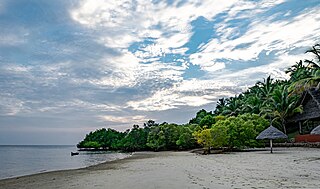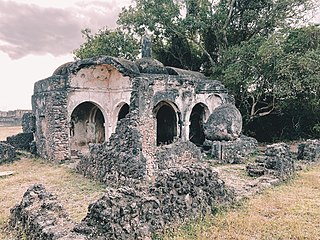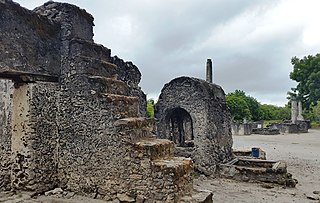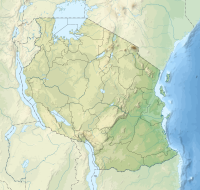
Mafia Island or Chole Shamba is an island of The Mafia Archipelago located in Mafia District in the southern Pwani Region of Tanzania across the Mafia Channel. The island is the third largest in Tanzanian ocean territory, but is not administratively included within the semi-autonomous region of Zanzibar, which has been politically separate since 1890. Mafia Island forms the largest part of Mafia District, one of the six administrative districts in the Pwani Region. As the Mafia Archipelago's main islan, is sometimes called Chole shamba in meaning Chole farmlands Swahili. This is in opposition to the historic settlement of Chole Mjini(Chole town) on Chole Island inside Mafia Bay. The island's population is over 40,000. The economy is based on fishing, subsistence agriculture and the market in Kilindoni. The island attracts some tourists, mainly scuba divers, birdwatchers, game fishermen, and people seeking relaxation.

Kilwa Kisiwani is an island, national historic site, and hamlet community located in the township of Kilwa Masoko, the district seat of Kilwa District in the Tanzanian region of Lindi Region in southern Tanzania. Kilwa Kisiwani is the largest of the nine hamlets in the town Kilwa Masoko and is also the least populated hamlet in the township with fewer than 1,000 residents.
The Swahili people comprise mainly Bantu, Afro-Arab and Comorian ethnic groups inhabiting the Swahili coast, an area encompassing the Zanzibar archipelago and mainland Tanzania's seaboard, littoral Kenya, northern Mozambique, the Comoros Islands and Northwest Madagascar.

Zanj was a name used by medieval Muslim geographers to refer to both a certain portion of Southeast Africa and to its Bantu inhabitants. This word is also the origin of the place-names Zanzibar and the Sea of Zanj.

Kilwa District is one of six administrative districts of Lindi Region in Tanzania. The District covers an area of 15,000 km2 (5,800 sq mi). The district is comparable in size to the land area of the nation state of East Timor. Kilwa district is bordered to the north by Rufiji District in Pwani Region, to the east by the Indian Ocean, to the south by the Lindi District, Nachingwea District together with Ruangwa District, and to the west by the Liwale District. The district borders every other district in Lindi Region except Lindi Municipal District. The district seat (capital) is the town of Kilwa Masoko. The district is named after the medieval Swahili city state of Kilwa Kisiwani. According to the 2012 census, the district has a total population of 190,744.

Kilwa Masoko or Masoko is an administrative ward in Kilwa District of Lindi Region in Tanzania. The ward covers an area of 200 km2 (77 sq mi), and has an average elevation of 11 m (36 ft). The ward is also the capital of Kilwa District. According to the 2012 census, the ward has a total population of 13,601.

Swahili architecture is a term used to designate a whole range of diverse building traditions practiced or once practiced along the eastern and southeastern coasts of Africa. Rather than simple derivatives of Islamic architecture from the Arabic world, Swahili stone architecture is a distinct local product as a result of evolving social and religious traditions, environmental changes, and urban development.

The Great Mosque of Kilwa is a congregational mosque on the island of Kilwa Kisiwani, in Kilwa Masoko in Kilwa District in Lindi Region of Tanzania. It was likely founded in the tenth century, but the two major stages of construction date to the eleventh or twelfth and thirteenth century, respectively. It is one of the earliest surviving mosques on the Swahili coast and is one of the first mosques built without a courtyard.

The Swahili coast is a coastal area of the Indian Ocean in East Africa inhabited by the Swahili people. It includes Sofala ; Mombasa, Gede, Pate Island, Lamu, and Malindi ; Dar es Salaam and Kilwa. In addition, several coastal islands are included in the Swahili coast such as Zanzibar and Comoros.
The Shirazi people, also known as Mbwera, are a Bantu ethnic group inhabiting the Swahili coast and the nearby Indian ocean islands. They are particularly concentrated on the islands of Zanzibar, Pemba and Comoros.

Kaole is a national historic site located in Bagamoyo District of Pwani Region in Tanzania. The site is located three miles east of the historic city of Bagamoyo on the Indian Ocean coast. The area contains old Swahili coral stone ruins dating to a period between the 13th century and the 16th century. Some of the ruins date back to the 13th century and consist of two mosques and 30 tombs.

Mafia District Council(Wilaya ya Mafia, in Swahili) is one of eight administrative districts of Pwani Region in Tanzania. It administers not only the main Mafia Island but the entire Mafia Archipelago. The District covers an area of 642.6 km2 (248.1 sq mi). The Sea of Zanj completely encircles the District. Rufiji District is located on the other side of the Mafia Channel to the west. The district is comparable in size to the land area of Saint Lucia. The town of Kilindoni serves as its administrative capital. The District is home to the largest concentration of Whale Sharks in Africa, Mafia Island Marine Park, Historic Chole Island Ruins, Kisimani Mafia and Kua Ruins; and Mlola Forest Reserve. According to the 2012 Tanzania National Census, the population of the District was 46,438.

Songo Mnara is a historic Swahiili settlement in located on Songo Mnara Island in Pande Mikoma, Kilwa District in Lindi Region of Tanzania. The island is home to a Medieval Swahili stone town. The stone town was occupied from the 14th to 16th centuries. Songo Mnara has been recognized as a UNESCO World Heritage Site, along with nearby stone town Kilwa Kisiwani. In total, archaeologists have found six mosques, four cemeteries, and two dozen house blocks along with three enclosed open spaces on the island. Songo Mnara was constructed from rough-coral and mortar. This stonetown was built as one of many trade towns on the Indian Ocean. The site is a registered National Historic Site.

Maritime archaeology in East Africa spans the range from the horn of Somalia south to Mozambique, and includes the various islands and island chains dotting the map off the coast of Somalia, Mozambique, Tanzania and Kenya. Primary areas along this coast include the Zanzibar, Lamu, and Kilwa Archipelagos. Although East African societies developed nautical capabilities for themselves, most of the maritime artifacts point to external merchants from Mediterranean cultures like Egypt and Greece, Indian and Chinese from South and East Asia in the early stages, to the great European powers during the Ages of Colonization and Imperialism.
Stephanie Wynne-Jones is an Africanist archaeologist, whose research focuses on East African material culture, society and urbanism. She is Professor and Deputy Head of the Department of Archaeology at the University of York. She previously worked as assistant director of the British Institute in Eastern Africa (2005-2008) and remains a Trustee and Member of the BIEA Governing Council. In 2016, Wynne-Jones was elected to Fellowship of the Society of Antiquaries of London. Wynne-Jones is one of the Core Group at the Danish National Research Foundation Centre of Excellence in Urban Network Evolutions (Urbnet), Aarhus University. Between 2015 and 2017 she was a Pro Futura Scientia Fellow at the Swedish Collegium for Advanced Study, Uppsala.

National Historic Sites of Tanzania is an official list of places in Tanzania that have been designated as National Historic Sites as per the Ministry of Natural Resources and Tourism of Tanzania under the Antiquities Division. The list is not complete and is currently being updated.
Sanje ya Kati is protected, uninhabited historic site located on Sanje ya Kati Island in Pande Mikoma ward in Kilwa District in Lindi Region of Tanzania's Indian Ocean coast. The site is home to medieval Swahili ruins that have yet to be fully excavated.
Mtambwe Kuu or Mtambwe Mkuu is a Medieval Swahili historic site located in Chake Chake District of Pemba North Region. A town wall, a mosque, tombs, and residences are among the several stone constructions at the Mtambwe Mkuu site in northwest Pemba. The oldest indications of occupation date from the eleventh century and persisted successfully and unbrokenly until the fifteenth century. It was once again occupied in the nineteenth century. A cache of over 2,000 gold and silver coins from the 10 and eleventh centuries were found during an excavation at the location, demonstrating Pemba's Swahili involvement in the regional trade networks at the time.
Mkia wa Ng'ombe Ruins is protected historic site located inside Micheweni District of Pemba North Region in Tanzania. The settlement was established around the 15th CE and abandoned in the 16th century. There are ruins of a mosque, tombs and some stone buildings. The site is critically endangered to further erosion.

Kunduchi is a Medieval Swahili National Historic Site located in Kunduchi ward, located in Kinondoni District of Dar es Salaam Region in Tanzania. There is an excavated 15th-century mosque on the site. An 18th-century cemetery with the biggest collection of pillared tombs in East Africa, situated in a baobab woodland, and embellished with Ming era's porcelain plates. The pottery discovered here demonstrates the medieval town's affluence and trading connections with imperial China.













